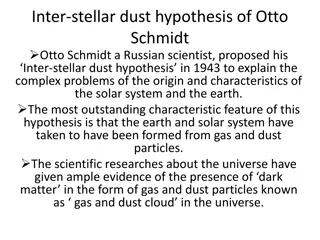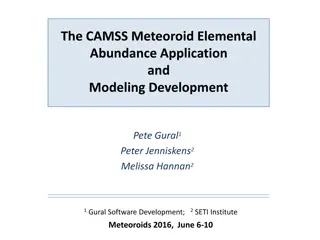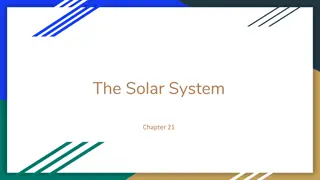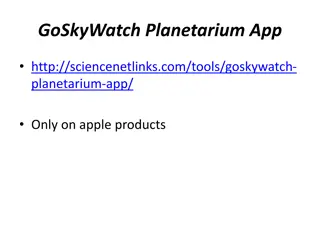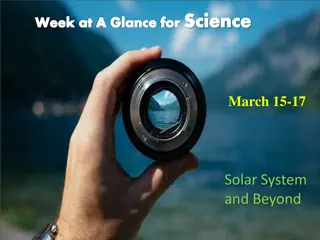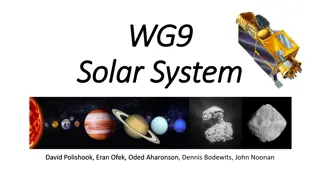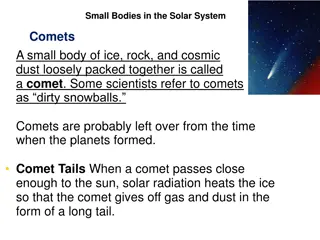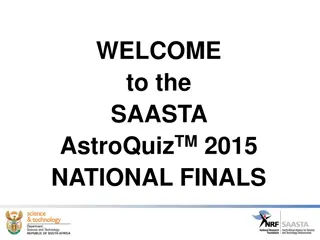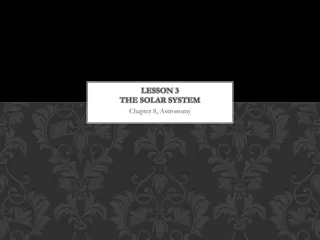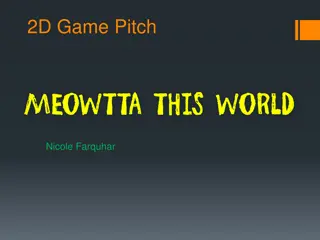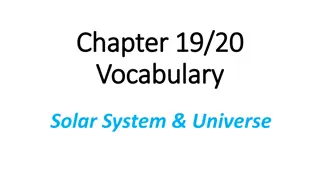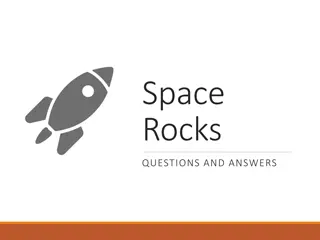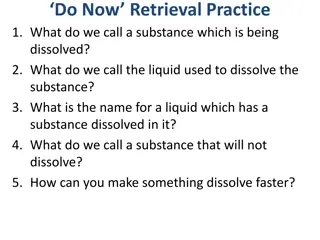The History of the Earth
The Earth, 4.5 billion years old, emerged from a nebula in the Milky Way Galaxy. Gravity led to the condensation of a rotating cloud into the Sun and planets. Over time, lumps collided, forming gas giants, rocky planets, and asteroids. The outer planets attracted hydrogen and helium, while the inner
2 views • 45 slides
The Interstellar Dust Hypothesis of Otto Schmidt Explained
Russian scientist Otto Schmidt proposed the Interstellar Dust Hypothesis in 1943 to explain the origin of the solar system and Earth. According to this hypothesis, gas and dust particles from the universe formed our solar system. The dark matter in the form of gas and dust clouds played a crucial ro
3 views • 5 slides
CAMSS Meteoroid Elemental Abundance Application and Modeling Development
Cameras for All-sky Meteor Surveillance Spectroscopy (CAMSS) aims to obtain meteoroid elemental abundances through relative ratios and absolute atom counts, sampling from comets and asteroids. The system uses grating cameras with high resolutions to automate spectral analysis processes. The CAMSS Co
0 views • 14 slides
Exploring the Solar System: A Fascinating Journey
Delve into the structure of the solar system, with the sun at its center surrounded by planets, asteroids, and comets. Learn about the inner rocky planets, outer gas giants, and tiny dwarf planets. Discover how distance is measured in space using astronomical units and unravel the motion of planets
0 views • 20 slides
Explore Space: Celestial Objects and Beyond
Dive into the wonders of the universe with this engaging lesson on space celestial objects. Discover the differences between comets and asteroids, explore planets and moons in our solar system, learn about stars, asteroids, comets, and galaxies, and unravel the mysteries of astronomy. Let your curio
0 views • 34 slides
Exploring the Solar System and Beyond: Week at a Glance for Science
Dive into a week focused on the wonders of the solar system and beyond. From comparing comets, asteroids, and meteoroids to understanding the position of the solar system in the Milky Way galaxy, students will engage in activities to enhance their knowledge. Explore the evolution of scientific views
0 views • 20 slides
Exploration of Asteroid Taxonomic Groups and Compositional Structure
Delve into the classification and analysis of varied asteroid taxonomic groups such as Silicate (S-type) and carbonaceous (C-type). Utilize NUV photometry data to distinguish between asteroid sub-groups and study compositional structures in the main asteroid belt. Investigate the dynamics of primiti
0 views • 10 slides
Small Bodies in the Solar System: Comets, Asteroids, and Meteoroids
Comets are icy rock bodies with tails that form when passing close to the sun. Asteroids are rocky bodies in the asteroid belt, with different compositions. Meteoroids are small rocky bodies revolving around the sun, creating meteor showers when entering Earth's atmosphere. The content discusses the
0 views • 9 slides
SAASTA AstroQuizTM 2015 National Finals - Test Your Astronomy Knowledge!
Get ready for the ultimate astronomy challenge at the SAASTA AstroQuizTM 2015 National Finals. Follow the rules, answer intriguing questions about the Milky Way, Radio Astronomy, Square Kilometer Array, planets, Earth's equator, asteroids, and space missions. Test your knowledge, compete with other
0 views • 42 slides
Exploring the Solar System: Planets, Orbits, and More
Dive into the fascinating world of the solar system with this chapter on Astronomy. Learn about planets, moons, asteroids, comets, and more as they orbit the Sun. Understand the forces of gravity and inertia that keep celestial bodies in motion and explore ancient ideas about planetary motion. Disco
0 views • 26 slides
Mysteries of Space Rocks: Questions and Answers
Explore the intriguing world of asteroids and comets with these thought-provoking questions and answers. Learn about the frequency of impact events, the targets of celestial debris, and the history of asteroid collisions with planets. Delve into meteorites, meteors, and the fascinating phenomena ass
0 views • 45 slides
Space Cadet Cats - Alien Invasion Adventure
Earth is under attack by alien space mice, and only the Space Cadet Cats can save it! Players control the cats in a spaceship, shooting missiles to destroy the invaders. Collect power-ups represented as milk cartons for extra lives. With a retro feel like Asteroids but with a modern touch, navigate
0 views • 10 slides
Exploring the Solar System and Universe: Vocabulary Overview
Explore key terms related to the Solar System and Universe, including concepts such as accretion, asteroids, the Big Bang Theory, black holes, clusters, comets, galaxies, light-years, nebulae, the Nebular Model, planets, and red giants. Enhance your understanding of these phenomena and their signifi
0 views • 19 slides
Exploring Space Rocks: Questions and Answers
Delve into the fascinating world of asteroids, comets, and meteorites with answers to intriguing questions such as the frequency of asteroid impacts, the impact on various celestial bodies, the history of asteroid collisions with planets, and more. Learn about meteorites, meteors, and cosmic impacts
0 views • 45 slides
Understanding Our Solar System and Orbits
Explore the composition and orbits of our solar system, including the Sun, planets, dwarf planets, moons, comets, asteroids, and artificial satellites. Understand the role of gravity in maintaining nearly circular orbits and discover how objects stay in orbit.
0 views • 11 slides

